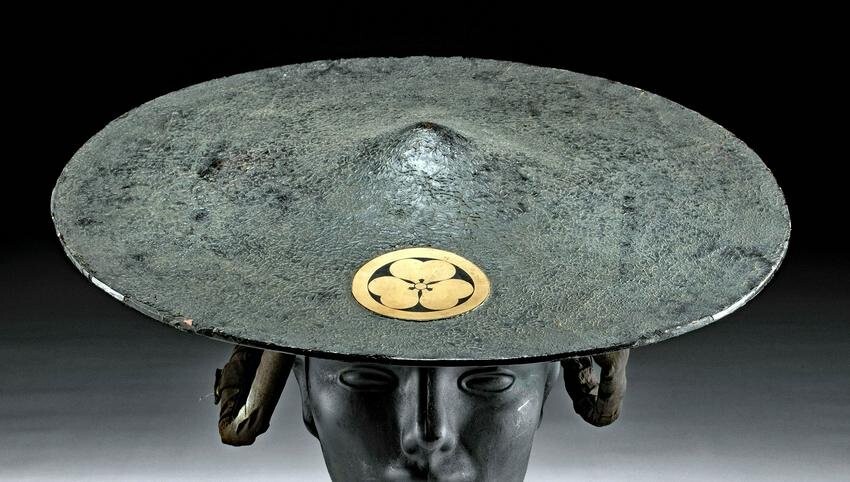19th C. Japanese Edo Lacquered Samurai Jingasa Hat
East Asia, Japan, Edo to Meiji period, ca. late 19th to early 20th century CE. A fine black-lacquered wood jingasa or camp hat of a shallow circular form with a gold-hued Maru Ni Katabami crest in the form of a tondo of a trefoil, or a creeping wood sorrel flower, on the brim. The interior presents a lustrous, black surface with gold-hued speckles and a central concave area for the wearer's head, with black, padded cloth straps. Jingasa hats were worn by Japanese samurais during travel or encampment. A red-painted lozenge motif further adorns the interior of the brim. Being lacquered, this jingasa was especially convenient as it was both waterproof and lightweight. Size: 16.3" Diameter x 2.6" H (41.4 cm x 6.6 cm)
Sankin kotai, known as "alternate attendance," was developed during the Warring States period as a system to strengthen the Tokugawa shogunate's control over the feudal lords known as daimyos. The daimyo would alternate between residing in the shogun's castle in Edo and his own fief, usually on a yearly basis. However, while the daimyo may return to his home fief, his family was required to remain in Edo with the Shogun, essentially as hostages to ensure loyalty while the daimyo was away. When traveling to Edo the daimyo was accompanied by samurai and jingasa hats were worn during travel or encampment as a protective helmet. Being lacquered, this jingasa was especially convenient as it was both waterproof and lightweight. During the Edo period, jingasa became more decorative for these sankin kotai processions.
Provenance: private Hawaii, USA collection; ex-M. Kobiashi collection, Hawaii, USA, acquired 1960 to 2000
All items legal to buy/sell under U.S. Statute covering cultural patrimony Code 2600, CHAPTER 14, and are guaranteed to be as described or your money back.
A Certificate of Authenticity will accompany all winning bids.
PLEASE NOTE: Due to recent increases of shipments being seized by Australian & German customs (even for items with pre-UNESCO provenance), we will no longer ship most antiquities and ancient Chinese art to Australia & Germany. For categories of items that are acceptable to ship to Australia or Germany, please contact us directly or work with your local customs brokerage firm.
Display stands not described as included/custom in the item description are for photography purposes only and will not be included with the item upon shipping.
#168417
Condition Report: Some surface wear with losses and chipping to lacquer, with loss at the periphery of rim. Some stains to padded fabric. Otherwise, intact and excellent.
View it on
Estimate
Time, Location
Auction House
East Asia, Japan, Edo to Meiji period, ca. late 19th to early 20th century CE. A fine black-lacquered wood jingasa or camp hat of a shallow circular form with a gold-hued Maru Ni Katabami crest in the form of a tondo of a trefoil, or a creeping wood sorrel flower, on the brim. The interior presents a lustrous, black surface with gold-hued speckles and a central concave area for the wearer's head, with black, padded cloth straps. Jingasa hats were worn by Japanese samurais during travel or encampment. A red-painted lozenge motif further adorns the interior of the brim. Being lacquered, this jingasa was especially convenient as it was both waterproof and lightweight. Size: 16.3" Diameter x 2.6" H (41.4 cm x 6.6 cm)
Sankin kotai, known as "alternate attendance," was developed during the Warring States period as a system to strengthen the Tokugawa shogunate's control over the feudal lords known as daimyos. The daimyo would alternate between residing in the shogun's castle in Edo and his own fief, usually on a yearly basis. However, while the daimyo may return to his home fief, his family was required to remain in Edo with the Shogun, essentially as hostages to ensure loyalty while the daimyo was away. When traveling to Edo the daimyo was accompanied by samurai and jingasa hats were worn during travel or encampment as a protective helmet. Being lacquered, this jingasa was especially convenient as it was both waterproof and lightweight. During the Edo period, jingasa became more decorative for these sankin kotai processions.
Provenance: private Hawaii, USA collection; ex-M. Kobiashi collection, Hawaii, USA, acquired 1960 to 2000
All items legal to buy/sell under U.S. Statute covering cultural patrimony Code 2600, CHAPTER 14, and are guaranteed to be as described or your money back.
A Certificate of Authenticity will accompany all winning bids.
PLEASE NOTE: Due to recent increases of shipments being seized by Australian & German customs (even for items with pre-UNESCO provenance), we will no longer ship most antiquities and ancient Chinese art to Australia & Germany. For categories of items that are acceptable to ship to Australia or Germany, please contact us directly or work with your local customs brokerage firm.
Display stands not described as included/custom in the item description are for photography purposes only and will not be included with the item upon shipping.
#168417
Condition Report: Some surface wear with losses and chipping to lacquer, with loss at the periphery of rim. Some stains to padded fabric. Otherwise, intact and excellent.



